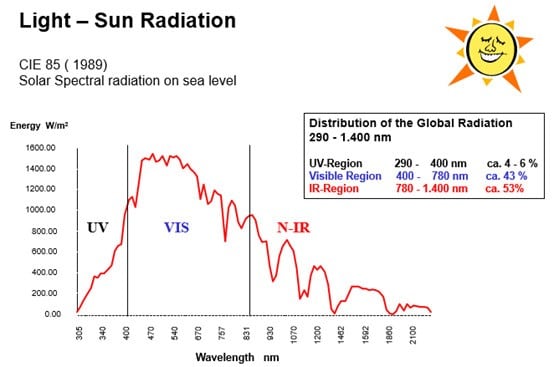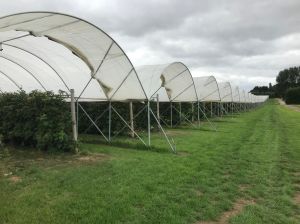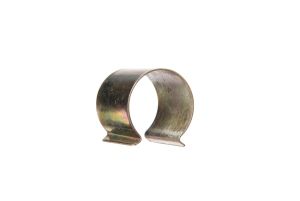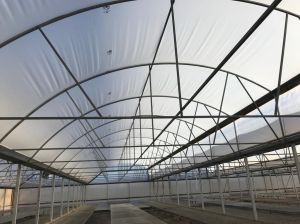Tunnel film: Light and sunshine

The different types of radiation that affect plant growth and development. Everything in our universe is interrelated. In a wondrous balance. The moon creates ebb and flow on the earth and affects it more than we think. Without the sun, life on earth would not be possible. Our Creator has made it wonderfully beautiful.

Light
The main source of light on earth is the sun. Sunlight provides the energy that green plants use to make sugars, usually in the form of starches, which release energy into the living things they digest. This process of photosynthesis provides virtually all the energy used by living things.
The sun's rays, which come to Earth, can be divided into 3 types of radiation.
- Ultra violet(UV) - from 220 nm to 400 nm
- Photosynthetically active radiation (PAR) - from 400 nm to 700 nm
- Infrared(IR) - from 780 nm to 1 nm.
This light is not all visible to us as humans. Visible light - from 380 to 700 nm - overlaps with PAR in most parts.


Ultra Violet (UV)
UV ranges from 100 nm to 400 nm. The ozone layer absorbs the shortwave part up to 290 nm. The UV range - although it is only 6% of the total radiation - is very energetic. Too much UV radiation is harmful to us as humans. UV radiation also causes the breakdown of viruses and fungi. UV can cause film degradation. The quality is degraded.
More phenomena related to UV: UV is essential for the development of some colors and fragments in flowers, vegetables and fruits. On the other hand, blocking the UV suppresses the activity of insects (Anti-Virus) and helps to improve film stabilization. UV blocking is needed when growing red roses. Some fungal species require UV light to activate sporulation; therefore, UV blocking will slow down this process.
Photosynthetically active radiation and visible light.
Light or visible light appears within the part of the electromagnetic spectrum that can be perceived by the human eye. Visible light is usually defined as wavelengths ranging from 380 nm to 740 nm.
For plants, most important is the Photosynthetically Active Radiation (PAR), ranging from 400 nm to 700 nm. This part of Light is essential for all plants. The irradiance of PAR can be measured in energy units (W/m2).

Source: https://nl.wikipedia.org/wiki/Plantenfysiologie
INFRAROOD (IR)
Infrared spectrum of light is the radiation ranging from 780 nm to 1 mm.
It is often divided into three subcategories:
- NIR (Near Infra-Red) - from 780 nm to 2,000 nm.
- MIR (Middle Infra-Red) - from 2,000 nm to 5,000 nm.
- FIR (Far Infra-Red) - from 5,000 nm to 1 mm.
Nir range can contribute to rapid warming and overheated greenhouses. In hot areas, the indoor temperature of the greenhouse can cause heat stress disorders in plants, such as: water loss, enhanced water uptake, reduced germination and early seedling growth, reduced crop productivity, leaf curling and folding, dehydration, burning of tips, etc.
Light and Foil
With all this knowledge it is possible to steer the crop. FruitSecurity Holland does not work with Politiv for nothing. Politiv is an Israeli producer of high-quality films.
UV and film
We offer a wide range of films. Each film has its own formulation based on the most advanced technology of stabilizers and absorbers to achieve maximum durability even under the highest radiation conditions.
POLITIV provides a wide film selection with varying degrees of UV blocking, starting with Anti-Virus and Anti Blackening, through Bee-friendly and UV Open or "Nectarine". POLITIV TDS specifies UV transmission in the relevant ranges.

Film and PAR
To measure the Par light radiation, the V Vis instrument is used in POLITIV laboratory. This instrument calculates the PAR percentage transmitted by the film when light flux is perpendicular to the film, according to industry standards (such as EN 2155-5, ASTM D 1003, etc.).
POLITIV provides a broad film portfolio with different degrees of light transmission (LT).

Film and infrared
Together with POLITIV, FruitSecurity Holland offers a variety of products that make it possible to reduce extreme temperatures in greenhouses: Milky, Smart Aluminum and Everest.
Far IR range (also called Thermal IR) allows the greenhouse to emit energy back to the sky (at night when no radiation is coming in). The temperature of the greenhouse can drop as a result of IR radiation. This happens when all heat radiation can leave the greenhouse unhindered by the foil.
Radiation can be blocked with film. Thermal IR film reduces heat loss during cold nights. POLITIV IR film is designed to absorb most of the IR radiation to prevent energy losses. The heat radiation is blocked, so to speak.
Thermicity is determined by the percentage of IR that passes through the film, ranging from 1400 cm-1 to 700 cm-1.
With the right knowledge of light and radiation it is possible to control. Together with Politiv, Fruitsecurity Holland is able to give the right advice.
|
Gerben van Veldhuizen Fruitprotection specialist My mission is to help as many fruit growers as possible get a good harvest. |












